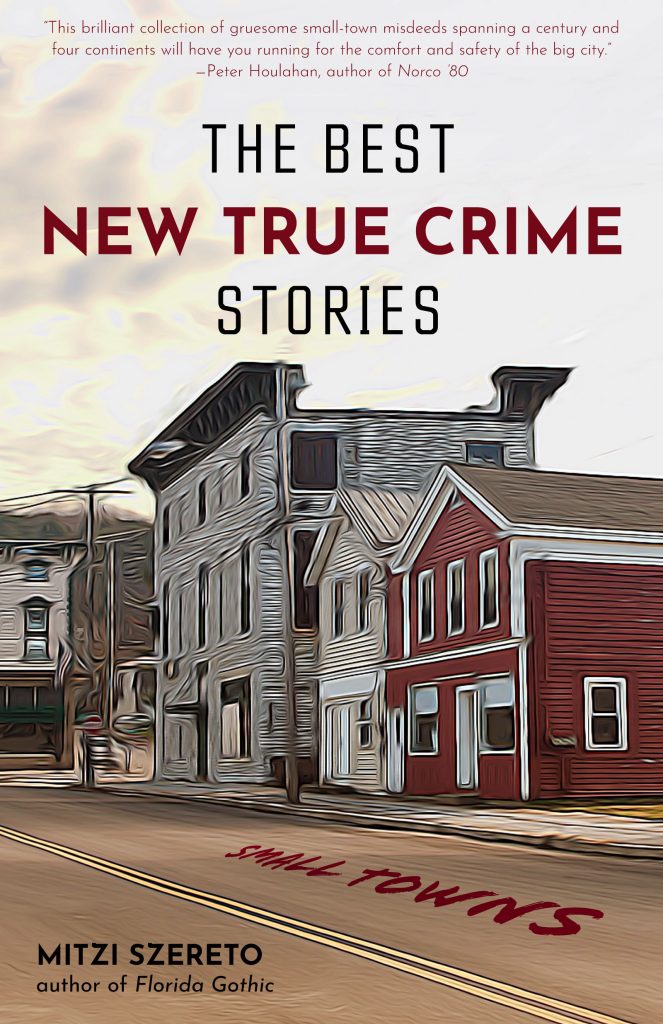
“The real monsters aren’t hiding in the woods—they’re in our towns!“
It seems like only yesterday when my debut true crime book The Best New True Crime Stories: Serial Killers was published. Now here we are, roughly three quarters of a year later and living in a very different world. Be that as it may, I’ve continued to toil away in my true crime workshop in order to bring you The Best New True Crime Stories: Small Towns, the second volume in my original anthology series.
Does it sound like I’m developing a true crime franchise here? The answer is yes!
I’ve been asked, “Why small towns?” Well, many of us have an idealised image of small towns. Modern life, particularly in urban areas, make us pine for a simpler and less frenetic lifestyle – one in which we don’t have to keep looking over our shoulders to see who’s creeping up behind us, harbouring ill intentions. Safe and friendly are qualities frequently associated with small-town living. But like so many things in life, the reality is often very different. Perhaps the small-town ideal is simply a myth. Because even the most “perfect” small town likely has something sinister lurking beneath the surface – and when it’s freed, watch out! It’s easy to assume that this is just another unfortunate result of living in today’s world (and there is definitely truth to that), but as some of the accounts in this book will show, things weren’t so pristine and wholesome in the past either.
It was a pleasure to work with so many fine writers from all over the world – the USA, Canada, Great Britain, Italy, Latin America, Australia, and the Caribbean. In fact, the stories in the book are as international as the writers. Contributors in this collection include Alexandra Burt, Christian Cipollini, Edward Butts, Tom Larsen, Mark Fryers, Anthony Ferguson, Deirdre Pirro, Joe Turner, C L Raven, Charlotte Platt, Stephen Wade, Iris Leona Marie Cross, Paul Williams, David Brasfield and, of course, me! Each story has been written specifically for this anthology – these are not reprints. We have true crime accounts from small towns in California, the Pacific Northwest, the American South, Canada, England, Scotland, Wales, Germany, Italy, Ecuador, and Trinidad. Which only goes to show that small towns, regardless of what country they’re in, are not immune when it comes to crime, especially crime of the deadlier kind.
Over the next few months I’ll be chatting with my contributors in special Facebook Live Events, which will stream to my author PAGE. These videos will also be available for later viewing, and posted on my WEBSITE (along with some random mugshots). We had a fantastic time doing these live streaming events for the previous book, The Best New True Crime Stories: Serial Killers. If you missed any and would like to catch up with these exclusive writer chats, you can do so HERE.
Now for a couple of teasers from the new book to whet your appetite:
From “The Summer of ‘the Fox'” by Mark Fryers
In 1984, as a six-year-old child, I moved to a small town in the South of England, where I would remain for the next twenty years. As I began school and met the neighborhood children, it became clear that I had moved into the aftermath of a tantalizing mystery (at least to a child with little life experience). I was offered glimpses, some true anecdotes, and wild schoolyard rumors that forged a mystery in my mind about an elusive figure known simply as “the Fox.” The Fox evaded capture and outwitted the police—almost like a comic-book hero. He was an enigma. As I grew older and gradually pieced together the truth of the situation, the romance faded and the true terror of the Fox’s reign was borne unto me, creating further complex puzzles and mysteries. He has haunted me ever since. But for those who were present that previous summer, the events on the small town and its outlying locales are indelibly inked as a summer of confusion and fear.
The market town of Leighton Buzzard, about forty miles north of London, is set in the picturesque Bedfordshire countryside not far from the Chiltern Hills, and apart from a blip in the 1960s when the “Great Train Robbery” took place nearby, it did little to trouble the headline writers of national newspapers for many years. That was until that fateful summer in 1984, where it stood at the nexus of a “triangle of fear.” The aforementioned “Fox” was a petty criminal, burglar, and sexual predator. Like his namesake, his cunning nature allowed him to go undetected in a reign of terror that lasted from March of that year in a triangular crime zone that straddled the borders of the three English home counties of Hertfordshire, Bedfordshire, and Buckinghamshire, until his eventual arrest in September.
The long, hot summer of 1984 initially promised to be no more eventful than those that preceded it. Leighton Buzzard largely stood apart from the events of the nuclear protests at Greenham Common and the fallout of the miner’s strike that continued to dominate national headlines that year. Indeed, the most it threatened were those with pollen allergies as the rapeseed plants covering the countryside in a pleasant undulating yellow neared their harvest. Even when the Fox began his crime spree, there was little to suggest the scale of terror that was to later blight Leighton Buzzard, and the sleepy villages and hamlets that bordered it. Although a pattern of similar crimes emerged, there was also, at least initially, little to suggest a serial attacker on the loose.
From “Who Killed Gabriele Schmidt: The True Story and the Mystery Surrounding a Forgotten Murder” by Alexandra Burt
June 1983. Fulda, Germany. Gabriele Schmidt, a five-year-old girl, is murdered. That day, I happen to be close to the scene of the crime, a quarter of a mile away, the way the crow flies. Not until decades later, after I finally locate the few articles that exist online, do I realize I was seventeen, almost an adult, but I felt so much more vulnerable, and I could have sworn I was much younger.
She disappears while playing in a courtyard of her house shared by multiple tenants. The abduction occurs in broad daylight with people bustling about, the yard visible from numerous windows, but no one sees or hears anything. Her body is found later that night. The search for the killer is swift and thorough, but yields no culprit and, though occasionally over the next twenty years the case is resurrected by the media, it never sends appropriate shockwaves beyond the town. The hairs on the back of my neck stand up as nuclear destruction haunts my dreams. And now there is a killer on the loose.
The details of the brutality and the violence inflicted upon Gabriele Schmidt are mostly guesswork. Officials are tight-lipped, and there is a deep and unsettling mystery surrounding her case; no press conferences, no minute details leaked to the media, and not a single newspaper beyond the local Zeitung picks up the story. I cringe when I call her “a story.” She’s so much more than that. Gabriele Schmidt won’t have her first day of school; she won’t ever learn to ride a bike, make friends, or fall in love; and her entire life will remain unlived. In the decades to come, the details of her murder are confined to less than a dozen online articles, while similar crimes are picked up by international newspapers. She all but died and took the story of the murder with her.

